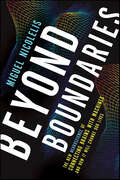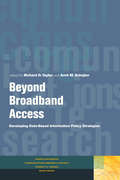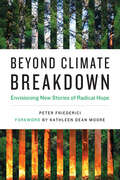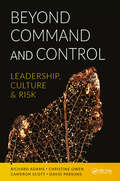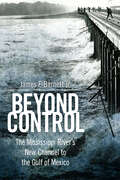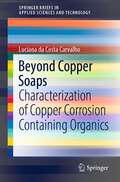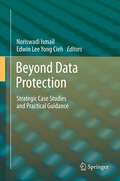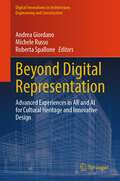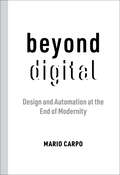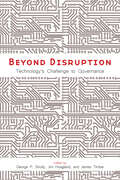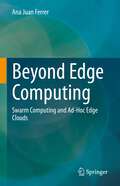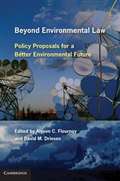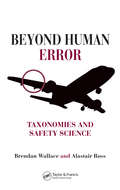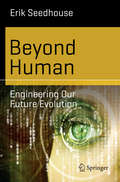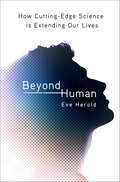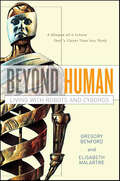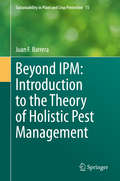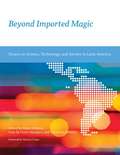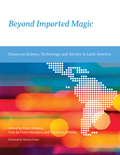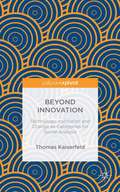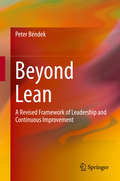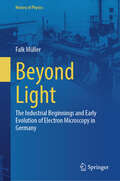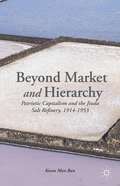- Table View
- List View
Beyond Boundaries: The New Neuroscience of Connecting Brains with Machines and How It Will Change Our Lives
by Miguel NicolelisA pioneering neuroscientist shows how the long-sought merger of brains with machines is about to become a paradigm-shifting realityImagine living in a world where people use their computers, drive their cars, and communicate with one another simply by thinking. In this stunning and inspiring work, Duke University neuroscientist Miguel Nicolelis shares his revolutionary insights into how the brain creates thought and the human sense of self—and how this might be augmented by machines, so that the entire universe will be within our reach.Beyond Boundaries draws on Nicolelis's ground-breaking research with monkeys that he taught to control the movements of a robot located halfway around the globe by using brain signals alone. Nicolelis's work with primates has uncovered a new method for capturing brain function—by recording rich neuronal symphonies rather than the activity of single neurons. His lab is now paving the way for a new treatment for Parkinson's, silk-thin exoskeletons to grant mobility to the paralyzed, and breathtaking leaps in space exploration, global communication, manufacturing, and more. Beyond Boundaries promises to reshape our concept of the technological future, to a world filled with promise and hope.
Beyond Broadband Access: Developing Data-Based Information Policy Strategies (Donald McGannon Communication Research Center's Everett C. Parker Book Series)
by Richard D. Taylor Amit M. SchejterAfter broadband access, what next? What role do metrics play in understanding “information societies”? And, more important, in shaping their policies? Beyond counting people with broadband access, how can economic and social metrics inform broadband policies, help evaluate their outcomes, and create useful models for achieving national goals? This timely volume not only examines the traditional questions about broadband, like availability and access, but also explores and evaluates new metrics more applicable to the evolving technologies of information access.Beyond Broadband Access brings together a stellar array of media policy scholars from a wide range of disciplines—economics, law, policy studies, computer science, information science, and communications studies. Importantly, it provides a well-rounded, international perspective on theoretical approaches to databased communications policymaking in the Americas, Europe, Asia, and Africa. Showcasing a diversity of approaches, this invaluable collection helps to meet myriad challenges to improving the foundations for communications policy development.
Beyond Climate Breakdown: Envisioning New Stories of Radical Hope (One Planet)
by Peter FriedericiThe importance of telling new climate stories—stories that center the persistence of life itself, that embrace comedy and radical hope.&“How dare you?&” asked teenage climate activist Greta Thunberg at the United Nations in 2019. How dare the world&’s leaders fiddle around the edges when the world is on fire? Why is society unable to grasp the enormity of climate change? In Beyond Climate Breakdown, Peter Friederici writes that the answer must come in the form of a story, and that our miscomprehension of the climate crisis comes about because we have been telling the wrong stories. These stories are pervasive; they come from long narrative traditions, sanctioned by capitalism, Hollywood, and social media, and they revolve around a myth: that the nation exists primarily as a setting for a certain kind of economic activity. Stories are how we make sense of the world and our place in it. The story that &“the economy&” takes priority over everything else may seem foreordained, but, Friederici explains, actually reflect choices made by specific people out of self-interest. So we need new stories—stories that center the persistence of life, rather than of capitalism, stories that embrace contradiction and complexity. We can create new stories based on comedy and radical hope. Comedy never says no; hope sprouts like a flower in cracked concrete. These attitudes require a new way of thinking—an adaptive attitude toward life that slips the narrow yoke of definition.
Beyond Command and Control: Leadership, Culture and Risk
by Richard Adams Christine Owen Cameron Scott David Phillip ParsonsThis book will advance the understanding of leadership beyond the inherited myths and modalities of command and control. Leadership is separated from ideas and institutional seniority and explained as the collaborative power of one with others. Enabling the intelligent co-participation of all people, the constructive effect of this approach to leadership is in the engagement of people. This is significant when task accomplishment depends not on managerial direction, but on the interaction of people with each other, with technical systems, and with complex regulations which are often across jurisdictional boundaries. Examples and case studies are included.
Beyond Control: The Mississippi River’s New Channel to the Gulf of Mexico (America's Third Coast Series)
by James F. Barnett Jr.Beyond Control reveals the Mississippi as a waterway of change, unnaturally confined by ever-larger levees and control structures. During the great flood of 1973, the current scoured a hole beneath the main structure near Baton Rouge and enlarged a pre-existing football-field-size crater. That night the Mississippi River nearly changed its course for a shorter and steeper path to the sea. Such a map-changing reconfiguration of the country’s largest river would bear national significance as well as disastrous consequences for New Orleans and towns like Morgan City, at the mouth of the Atchafalaya River. Since 1973, the US Army Corps of Engineers Control Complex at Old River has kept the Mississippi from jumping out of its historic channel and plunging through the Atchafalaya Basin to the Gulf of Mexico. Beyond Control traces the history of this phenomenon, beginning with a major channel shift around 3,000 years ago. By the time European colonists began to explore the Lower Mississippi Valley, a unique confluence of waterways had formed where the Red River joined the Mississippi, and the Atchafalaya River flowed out into the Atchafalaya Basin. A series of human alterations to this potentially volatile web of rivers, starting with a bend cutoff in 1831 by Captain Henry Miller Shreve, set the forces in motion for the Mississippi’s move into the Atchafalaya Basin. Told against the backdrop of the Lower Mississippi River’s impending diversion, the book’s chapters chronicle historic floods, rising flood crests, a changing strategy for flood protection, and competing interests in the management of the Old River outlet. Beyond Control is both a history and a close look at an inexorable, living process happening now in the twenty-first century.
Beyond Copper Soaps: Characterization of Copper Corrosion Containing Organics (SpringerBriefs in Applied Sciences and Technology)
by Luciana da CarvalhoThis book reports a series of electrochemical experiments where copper was corroded in the presence of various organic substances. Combining data from spectroscopy techniques, X-ray diffraction and mass spectrometry (including proteomics) the experiments demonstrate that copper-organic complexes can be formed during the corrosion of copper. The low solubility of copper-organic complexes in organic solvents and their amorphous nature mean that these compounds cannot be easily detected by one single analytical technique. This book benefits researchers investigating the presence of organic residues in archaeological copper corrosion and copper-organic complexes in art, where sampling is often subject to curatorial constraints.
Beyond Data Protection: Strategic Case Studies and Practical Guidance
by Edwin Lee Yong Cieh Noriswadi IsmailThe book deals with data protection issues from practical viewpoints. 40% of the content focus on the Malaysian Personal Data Protection Act (PDPA) 2010 progress, whilst 60% of the content focus on leading comparative practical guidance from Europe. Part of the PDPA provisions is mirrored from European approaches and practices. The approach of this book is straightforward, handy and readable and is supplemented by practical applications, illustrations, tables and diagrams. Practical examples highlighted in this book range from cloud computing, radio frequency identification technology, social media networks and information security to basic related aspects of data protection issues covering strategic leadership, management, governance and audit in businesses, organisations and local authorities. Recommended best practices have been outlined for practical guidance accompanied with future challenges and opportunities for Malaysia and ASEAN. The book is equally suitable for academics, practitioners, governmental officials and regulators dealing with data protection within their sector-specific legislation.
Beyond Digital Representation: Advanced Experiences in AR and AI for Cultural Heritage and Innovative Design (Digital Innovations in Architecture, Engineering and Construction)
by Andrea Giordano Michele Russo Roberta SpalloneThis book collects contributions which showcase the impact of new augmented reality (AR) and artificial intelligence (AI) technologies considered jointly in the fields of cultural heritage and innovative design. AR is an alternative path of analysis and communication if applied to several fields of research, in particular if related to space and artifacts in it. This happens because the neural network development strengthens the relationship between augmented reality and artificial intelligence, creating processes close to human thought in shorter times. In the last years, the AR/AI expansion and the future scenarios have raised a deep trans-disciplinary speculation. The disciplines of representation (drawing, surveying, visual communication), as a convergence place of multidisciplinary theoretical and applicative studies related to architecture, city, environment, tangible and intangible cultural heritage, are called to contribute to the international debate. The book chapters deal with augmented reality and artificial intelligence, analyzing their connections as research tools for knowing the environment. In particular, the topics focus on the intersection between real and virtual world and on the heuristic role of drawing in the enhancement and management of cultural heritage, in planning and monitoring the architecture, the environment, or the infrastructures. Scientists involved in AR and AI research applied separately or together in the field of cultural heritage, architectural design, urban planning, and infrastructures analysis, as well as members of public and private organizations make up interdisciplinary groups that fuel the discussion focusing on the priorities and aims of the research related to the disciplines of representation.
Beyond Digital: Design and Automation at the End of Modernity
by Mario CarpoRecasting computational design: a new modern agenda for a post-industrial, post-pandemic world.Mass production was the core technical logic of industrial modernity: for the last hundred years, architects and designers have tried to industrialize construction and standardize building materials and processes in the pursuit of economies of scale. But this epochal march of modernity is now over. In Beyond Digital, Mario Carpo reviews the long history of the computational mode of production, showing how the merger of robotic automation and artificial intelligence will stop and reverse the modernist quest for scale. Today&’s technologies already allow us to use nonstandard building materials as found, or as made, and assemble them in as many nonstandard, intelligent, adaptive ways as needed: the microfactories of our imminent future will be automated artisan shops.The post-industrial logic of computational manufacturing has been known and theorized for some time. By tracing its theoretical and technical sources, and reviewing the design theories that accompanied its rise, Carpo shows how the computational project, long under the sway of powerful antimodern ideologies, is now being recast by the urgency of the climate crisis, which has vindicated its premises—and by the global pandemic, which has tragically proven its viability. Looking at the work of a new generation of designers, technologists, and producers, Beyond Digital offers a new modern agenda for our post-industrial future.
Beyond Disruption: Technology's Challenge to Governance
by George P. Shultz James Timbie Jim HoaglandIn Beyond Disruption: Technology's Challenge to Governance, George P. Shultz, Jim Hoagland, and James Timbie present views from some of the country's top experts in the sciences, humanities, and military that scrutinize the rise of post-millennium technologies in today's global society. They contemplate both the benefits and peril carried by the unprecedented speed of these innovations—from genetic editing, which enables us new ways to control infectious diseases, to social media, whose ubiquitous global connections threaten the function of democracies across the world. Some techniques, like the advent of machine learning, have enabled engineers to create systems that will make us more productive. For example, self-driving vehicles promise to make trucking safer, faster, and cheaper. However, using big data and artificial intelligence to automate complex tasks also ends up threatening to disrupt both routine professions like taxi driving and cognitive work by accountants, radiologists, lawyers, and even computer programmers themselves.
Beyond Edge Computing: Swarm Computing and Ad-Hoc Edge Clouds
by Ana Juan FerrerThis book explores the most recent Edge and Distributed Cloud computing research and industrial advances, settling the basis for Advanced Swarm Computing developments. It features the Swarm computing concepts and realizes it as an Ad-hoc Edge Cloud architecture.Unlike current techniques in Edge and Cloud computing that solely view IoT connected devices as sources of data, Swarm computing aims at using the compute capabilities of IoT connected devices in coordination with current Edge and Cloud computing innovations. In addition to being more widely available, IoT-connected devices are also quickly becoming more sophisticated in terms of their ability to carry considerable compute and storage resources. Swarm computing and Ad-hoc Edge Cloud take full advantage of this trend to create on-demand, autonomic and decentralized self-managed computing infrastructures.Focusing on cognitive resource and service management, the book examines the specific research challenges of the Swarm computing approach, related to the characteristics of IoT connected devices that form the infrastructure. It also offers academics and practitioners insights for future research in the fields of Edge and Swarm computing.
Beyond Environmental Comfort
by Boon Lay OngBeyond Environmental Comfort highlights some of the key ideas that form the foundation of the field of environmental comfort and, at the same time, gives voice to some of the concerns and considerations on the limitations of the field as it stands today. Bringing together a range of foremost thinkers in their respective fields - Michel Cabanac, Derek Clements-Croome, Nick Baker, Harold Marshall, Juhani Pallasmaa, Dean Hawkes, and Constance Classen - this book argues for a deeper appreciation of how environmental comfort may be understood in terms of our relationship with the environment rather than as independent qualities. For the first time these diverse views are brought together by Editor Boon Lay Ong to present insights into a world beyond what is normally covered in academic research. In the process, an attempt is made to define the field for the future. This book shows that it is by understanding just how environmental design needs to go beyond mere comfort and deal with well-being that we can meaningfully design our future.
Beyond Environmental Law
by Alyson C. Flournoy David M. DriesenThis book offers a vision for the third generation of environmental law designed to enhance its ability to protect our environment. The book presents two core proposals, an Environmental Legacy Act to preserve a defined environmental legacy for future generations and an Environmental Competition Statute to spark movement to new clean technologies. The first proposal would require, for the first time, that the federal government define an environmental legacy that it must preserve for future generations. The second would establish a market competition to maximize environmental protection. The balance of the book provides complimentary proposals and analysis. The first generation of environmental law sought broad protection of health and the environment in a fairly fragmented way. The second sought to enhance environmental law's efficiency through cost-benefit analysis and market mechanisms. These proposals seek to create a broader, more creative approach to solving environmental problems.
Beyond Everywhere: How Wi-Fi Became the World's Most Beloved Technology
by Greg EnnisThe fascinating international story of the people who created Wi-Fi, their early battles against skeptical opponents, and how it ultimately exploded across the globe to become synonymous with the internet itself—as told by one of Wi-Fi&’s central figures.Eighteen billion Wi-Fi devices are in use around the world, with four billion more added every year. Connecting everyone to everything, it is central to our lives today. How did this happen? Beyond Everywhere is the surprising story in its entirety: the techno/political conflicts at its birth, the battles against competing technologies as it was being nurtured, and the international diplomatic intrigue as it spread across the planet. This vivid narrative about the people who gave Wi-Fi to the world is told with humor, insight, and charm by one of Wi-Fi&’s key developers. &“Whether you are a fan of technology or simply a fan of great storytelling, you will be captivated by Beyond Everywhere, the heretofore untold story of how the fundamental Wi-Fi connectivity we all rely on came to be. Because of his unique and longstanding position at the very center of the Wi-Fi world, there is no one better than Greg Ennis to tell this dramatic tale. Now synonymous with the internet itself—and with billions of users—the Wi-Fi story has finally been told.&” —Edgar Figueroa, President and CEO, Wi-Fi Alliance
Beyond Human Error: Taxonomies and Safety Science
by Alastair Ross Brendan WallaceA ground-breaking new book, Beyond Human Error: Taxonomies and Safety Science deconstructs the conventional concept of human error and provides a whole new way of looking at accidents and how they might be prevented. The majority of accidents and incidents are caused, at some level, by human error. This text provides an introduction to this key field as well as a broad background to the subject. Incorporating the sociology of disaster and accidents into a practical framework, it offers a new paradigm for the subject. The authors address the roots ofhuman error in the Western tradition and discuss the history of human error studies, human factors, and ergonomics, exploring hidden assumptions that have colored past research. They include current methodologies of experimental design, new paradigms, and outlines situated and distributed cognition models, and more useful intervention strategies.
Beyond Human: Engineering Our Future Evolution (Science and Fiction)
by Erik SeedhouseBeyond Human is an informative and accessible guide for all those interested in the developing sciences of genetic engineering, bio printing and human cloning. Illustrating the ideas with reference to well-known science fiction films and novels, the author provides a unique insight into and understanding of how genetic manipulation, cloning, and other novel bio-technologies will one day allow us to redesign our species. It also addresses the legitimate concerns about "playing God", while at the same time embracing the positive aspects of the scientific trajectory that will lead to our transhuman future.
Beyond Human: How Cutting-Edge Science is Extending Our Lives
by Eve HeroldNever before in the history of medicine has mankind faced such hope and peril as those of us poised to embrace the radical medical technologies of today. Eve Herold's Beyond Human examines the medical technologies taking shape at the nexus of computing, microelectronics, engineering, nanotechnology, cellular and gene therapies, and robotics. These technologies will dramatically transform our lives and allow us to live for hundreds of years. Yet, with these blessings come complicated practical and ethical issues, some of which we can predict, but many we cannot. Beyond Human taps the minds of doctors, scientists, and engineers engaged in developing a host of new technologies while telling the stories of some of the patients courageously testing the radical new treatments about to come into the market. Beyond Human asks the difficult questions of the scientists and bioethicists who seek to ensure that as our bodies and brains become ever more artificial, we hold onto our humanity. In this new world, will everyone have access to technological miracles, or will we end up living in a world of radical disparities? How will society accommodate life spans that extend into hundreds of years? Will we and our descendants be able to bring about the dream of a future liberated by technology, or will we end up merely serving the machines and devices that keep us healthy, smart, young, and alive?
Beyond Human: Living with Robots and Cyborgs
by Gregory Benford Elisabeth MalartreConcepts once purely fiction -- robots, cyborg parts, artificial intelligences -- are becoming part of everyday reality. Soon robots will be everywhere, performing surgery, exploring hazardous places, making rescues, fighting fires, handling heavy goods. After a decade or two, they will be as unremarkable as the computer screen is now in offices, airports or restaurants.Cyborgs will be less obvious. These additions to the human body are interior now, as rebuilt joints, elbows and hearts. Soon we will cross the line between repair and augmentation, probably first in sports medicine, then spreading to everyone who wants to make a body perform better, last longer, than it ordinarily could. Controversy will arise, but it will not stop the desire to live longer and be stronger than we are. Gregory Benford and Elisabeth Malartre's Beyond Human treats the landscape of human self-change and robotic development as poles of the same general phenomenon.At the Publisher's request, this title is being sold without Digital Rights Management Software (DRM) applied.
Beyond IPM: Introduction to the Theory of Holistic Pest Management (Sustainability in Plant and Crop Protection #15)
by Juan F. BarreraAbout 15 years ago, we asked ourselves why the methods developed by the research institutions for the management of pests were almost not used by small landholder farmers. It seemed obvious to us that conventional pest control –called “Integrated Pest Management”– was based on a reductionist approach. In reviewing the literature on the subject, we found that our concern was not new or unique. The agreement of some authors with our ideas reinforced our efforts to find a holistic approach to pest management. We took two central ideas to develop the holistic approach: First, pest management actions must put the farmer at the center of the system. Second, pest management must consider not only both pests but the other important components of the system in question. This approach based on the farmers and the systems in which they are immersed, is called “Holistic Pest Management” or HPM. In this book, I present the philosophy and practice of HPM, a new paradigm of pest management.
Beyond Imported Magic: Essays on Science, Technology, and Society in Latin America
by Eden Medina Marcos Cueto Ivan da Costa Marques Christina HolmesThe essays in this volume study the creation, adaptation, and use of science and technology in Latin America. They challenge the view that scientific ideas and technology travel unchanged from the global North to the global South -- the view of technology as "imported magic." They describe not only alternate pathways for innovation, invention, and discovery but also how ideas and technologies circulate in Latin American contexts and transnationally. The contributors' explorations of these issues, and their examination of specific Latin American experiences with science and technology, offer a broader, more nuanced understanding of how science, technology, politics, and power interact in the past and present.The essays in this book use methods from history and the social sciences to investigate forms of local creation and use of technologies; the circulation of ideas, people, and artifacts in local and global networks; and hybrid technologies and forms of knowledge production. They address such topics as the work of female forensic geneticists in Colombia; the pioneering Argentinean use of fingerprinting technology in the late nineteenth century; the design, use, and meaning of the XO Laptops created and distributed by the One Laptop per Child Program; and the development of nuclear energy in Argentina, Mexico, and Chile.ContributorsPedro Ignacio Alonso, Morgan G. Ames, Javiera Barandiarán, João Biehl, Anita Say Chan, Amy Cox Hall, Henrique Cukierman, Ana Delgado, Rafael Dias, Adriana Díaz del Castillo H., Mariano Fressoli, Jonathan Hagood, Christina Holmes, Matthieu Hubert, Noela Invernizzi, Michael Lemon, Ivan da Costa Marques, Gisela Mateos, Eden Medina, María Fernanda Olarte Sierra, Hugo Palmarola, Tania Pérez-Bustos, Julia Rodriguez, Israel Rodríguez-Giralt, Edna Suárez Díaz, Hernán Thomas, Manuel Tironi, Dominique Vinck
Beyond Imported Magic: Essays on Science, Technology, and Society in Latin America (Inside Technology)
by Eden Medina Ivan da Costa Marques Christina HolmesStudies challenging the idea that technology and science flow only from global North to South.The essays in this volume study the creation, adaptation, and use of science and technology in Latin America. They challenge the view that scientific ideas and technology travel unchanged from the global North to the global South—the view of technology as “imported magic.” They describe not only alternate pathways for innovation, invention, and discovery but also how ideas and technologies circulate in Latin American contexts and transnationally. The contributors' explorations of these issues, and their examination of specific Latin American experiences with science and technology, offer a broader, more nuanced understanding of how science, technology, politics, and power interact in the past and present.The essays in this book use methods from history and the social sciences to investigate forms of local creation and use of technologies; the circulation of ideas, people, and artifacts in local and global networks; and hybrid technologies and forms of knowledge production. They address such topics as the work of female forensic geneticists in Colombia; the pioneering Argentinean use of fingerprinting technology in the late nineteenth century; the design, use, and meaning of the XO Laptops created and distributed by the One Laptop per Child Program; and the development of nuclear energy in Argentina, Mexico, and Chile.ContributorsPedro Ignacio Alonso, Morgan G. Ames, Javiera Barandiarán, João Biehl, Anita Say Chan, Amy Cox Hall, Henrique Cukierman, Ana Delgado, Rafael Dias, Adriana Díaz del Castillo H., Mariano Fressoli, Jonathan Hagood, Christina Holmes, Matthieu Hubert, Noela Invernizzi, Michael Lemon, Ivan da Costa Marques, Gisela Mateos, Eden Medina, María Fernanda Olarte Sierra, Hugo Palmarola, Tania Pérez-Bustos, Julia Rodriguez, Israel Rodríguez-Giralt, Edna Suárez Díaz, Hernán Thomas, Manuel Tironi, Dominique Vinck
Beyond Innovation: Technology, Institution and Change as Categories for Social Analysis
by Thomas KaiserfeldBeyond Innovation counter weighs the present innovation monomania by broadening our thinking about technological and institutional change. It is done by a multidisciplinary review of the most common ideas about the dynamics between technology and institutions.
Beyond Lean: A Revised Framework of Leadership and Continuous Improvement
by Peter BéndekThis book by Peter Béndek presents a strong case against the current practice of business operations improvement, based on numerous studies from the business world as well as insights from the most prestigious authors of the last fifty years. The author contests the applicability and indeed the relevance of the Toyota Production System and its spin-offs to the Western context, claiming that a revised approach is much better suited to taking our specific cultural conditions into account, while also combining increased transparency, speed, and sustainability of change with a robust value-creating capability. Dr. Béndek argues that this approach can have a far-reaching impact on corporate cultures by offering an all-encompassing learning system, one that provides a more coherent and actionable continuous improvement strategy than conventional approaches. The book offers an important guide to rethinking operations management, both in academia and business practice.
Beyond Light: The Industrial Beginnings and Early Evolution of Electron Microscopy in Germany (History of Physics)
by Falk MüllerAs a powerful research technology, electron microscopy has shaped various natural and technical sciences. With its help, previously invisible pathogens such as viruses or bacteriophages became visible. After first successes in medical and biological research, it became a crucial research tool in the materials sciences, in chemistry, and solid state physics. The book focuses on the emergence and genesis of electron microscopy in Germany – from its beginnings in the early 1930s to the 1960s. Large corporations such as Siemens and AEG vied for supremacy in the development and sale of this innovative technology. In its early development, the success story of the electron microscope was characterized by strategic calculations, propaganda work, and tough patent negotiations, by conflicts among the protagonists over an appropriate place in future memory and by the entanglements with officials and organizations of the National Socialist State. The scientific and technical contributions of the electrical engineer and 1986 Nobel Prize winner in physics, Ernst Ruska, serve as a biographical thread.
Beyond Market and Hierarchy
by Kwan Man BunBased on extensive archival research, Beyond Market and Hierarchy reconstructs how Fan waged modern China's war of salts. Led by his Jiuda Salt Industries, the nascent refined salt industry battled revenue farmers who, as a group, monopolized the production and distribution of evaporated salt.
